|
Historical
Information

Soon after Gilbert Knapp
constructed a trading post and warehouse at the mouth of the Root River
in 1834, it became clear that the settlement which would become known as
Racine was destined for growth.
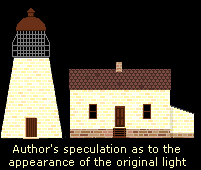 After the Committee on Commerce
responded favorably to an investigation into the need for constructing
an aid to navigation at Root River in 1836, Congress appropriated the
sum of $5,000 for the construction of a lighthouse at the rivers mouth
on March 3, 1837. Work began following year, with both the stubby
thirty-four foot tower and the keepers dwelling constructed of local
brick, whitewashed for daytime visibility. The light was displayed for
the first time the following year, and as with most US lighthouses
constructed at that time, was almost certainly fitted with a
birdcage-style lantern containing an array of Lewis lamps. After the Committee on Commerce
responded favorably to an investigation into the need for constructing
an aid to navigation at Root River in 1836, Congress appropriated the
sum of $5,000 for the construction of a lighthouse at the rivers mouth
on March 3, 1837. Work began following year, with both the stubby
thirty-four foot tower and the keepers dwelling constructed of local
brick, whitewashed for daytime visibility. The light was displayed for
the first time the following year, and as with most US lighthouses
constructed at that time, was almost certainly fitted with a
birdcage-style lantern containing an array of Lewis lamps.
While no illustrations of this original
station have surfaced, and we have thus far been unable to locate
original specifications, it is highly likely that it was designed and
constructed along the same plan as the New Buffalo Light which was under
constructed at the same time, and likely appeared similar to the
illustration appearing to the left.
As part of the system-wide upgrading by
the newly formed Lighthouse Board, the station's illumination was
upgraded to a fixed white Fifth Order Fresnel lens in 1858. By virtue of
the light's location close to the city, the lamp was subsequently
illuminated with city gas, as an early experiment at some time before
1861.
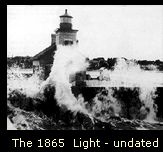 Racine's maritime commerce continued to
grow, and after a series of memorials from the citizens of Wisconsin
were presented by Wisconsin Congressman Henry Dodge , the United States
Army Corps of Engineers was charged with improving the harbor through
the construction of wooden protective piers on each side of the river's
mouth. A contract for their construction was subsequently awarded in
1861, however the contract was forfeited after the contractor claimed to
deliver a sufficient quantity of lumber for the project, claiming that
there was a shortage of the commodity. The project was placed under the
direct supervision of the Engineer in charge, who evidently soon found
that there was some truth in the contractor's claims, as he too found
himself unable to obtain the necessary lumber on the open market.
Deeming that completion of the project was of a higher priority , he was
forced to suspend the construction of similar piers in Milwaukee,
transferring the timber to Racine for the project's eventual completion
in 1864. Racine's maritime commerce continued to
grow, and after a series of memorials from the citizens of Wisconsin
were presented by Wisconsin Congressman Henry Dodge , the United States
Army Corps of Engineers was charged with improving the harbor through
the construction of wooden protective piers on each side of the river's
mouth. A contract for their construction was subsequently awarded in
1861, however the contract was forfeited after the contractor claimed to
deliver a sufficient quantity of lumber for the project, claiming that
there was a shortage of the commodity. The project was placed under the
direct supervision of the Engineer in charge, who evidently soon found
that there was some truth in the contractor's claims, as he too found
himself unable to obtain the necessary lumber on the open market.
Deeming that completion of the project was of a higher priority , he was
forced to suspend the construction of similar piers in Milwaukee,
transferring the timber to Racine for the project's eventual completion
in 1864.
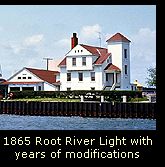 With the completion of these new piers,
the new entrance to the Root River had effectively been moved further
from the shoreline, and the old coast light was no longer able to serve
as an effective guide into the harbor. To remedy this situation, work
began on a new schoolhouse-style lighthouse constructed on a crib built
into the north pier. Over the summer of 1865, the new Cream City brick
structure began to take shape. Similar in design to the structures
subsequently built at Peninsula Point and
Sand Point in Escanaba
Harbor, the new station's
tower attached to the east end of the keepers dwelling stood 36 feet
from the foundation to the lantern, and provided the fixed white Fourth
Order Fresnel lens a focal plane of 48 feet, and a visibility range of
13 miles in clear weather. Construction would to a close at the end of
the summer, and the light was exhibited for the first time on the
evening of September 10, 1865. No longer needed, the old Root River
light was simultaneously discontinued. With the completion of these new piers,
the new entrance to the Root River had effectively been moved further
from the shoreline, and the old coast light was no longer able to serve
as an effective guide into the harbor. To remedy this situation, work
began on a new schoolhouse-style lighthouse constructed on a crib built
into the north pier. Over the summer of 1865, the new Cream City brick
structure began to take shape. Similar in design to the structures
subsequently built at Peninsula Point and
Sand Point in Escanaba
Harbor, the new station's
tower attached to the east end of the keepers dwelling stood 36 feet
from the foundation to the lantern, and provided the fixed white Fourth
Order Fresnel lens a focal plane of 48 feet, and a visibility range of
13 miles in clear weather. Construction would to a close at the end of
the summer, and the light was exhibited for the first time on the
evening of September 10, 1865. No longer needed, the old Root River
light was simultaneously discontinued.
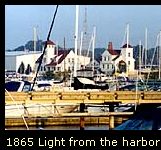 Perhaps as a result of damage incurred
when a vessel crashed into the east side of the structure the previous
year, the station's lens was upgraded from a Fifth Order Fresnel with a
180° arc of illumination to a Fourth Order Fresnel with a 270° arc of
illumination in 1870. Perhaps as a result of damage incurred
when a vessel crashed into the east side of the structure the previous
year, the station's lens was upgraded from a Fifth Order Fresnel with a
180° arc of illumination to a Fourth Order Fresnel with a 270° arc of
illumination in 1870.
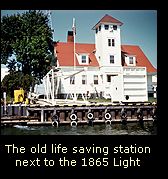 Maritime commerce in and out of Racine
experience continued growth, and the piers continued to be lengthened
commensurately to contain an ever expanding area of protection. With
such lengthening, It was inevitable that a pier head light would be
needed to mark the ends of the lengthened piers, and to that end a
Lighthouse Board work party arrived in Racine in July, 1872 to construct
a standard wooden beacon light with elevated walk at the outer end of
the north pier. Work progressed quickly, with the new light exhibited
for the first time on the night of September 5 of that year. Maritime commerce in and out of Racine
experience continued growth, and the piers continued to be lengthened
commensurately to contain an ever expanding area of protection. With
such lengthening, It was inevitable that a pier head light would be
needed to mark the ends of the lengthened piers, and to that end a
Lighthouse Board work party arrived in Racine in July, 1872 to construct
a standard wooden beacon light with elevated walk at the outer end of
the north pier. Work progressed quickly, with the new light exhibited
for the first time on the night of September 5 of that year.
The old 1838 coast light was demolished
in 1876, its timbers and bricks reportedly used in the construction of a
private dwelling.
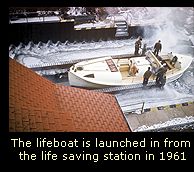 With continued lengthening of the
harbor piers, it was decided to
replace the 1865 Root River Light with a larger steel light at the
pierhead, and with the construction of this new steel light, the 1865 Light was simultaneously discontinued, and work began on
converting the old station into a dwelling large enough for the head
keeper and his assistant. The lens, lantern, and spiral iron tower
stairs were removed, and the tower capped with a hipped roof. The first
floor was converted to quarters for the head keeper, and dormers were
added to the second floor to create quarters for the assistant keeper.
Construction of a wooden staircase connecting the two floors completed
the conversion, and the keepers moved back into the renovated building. With continued lengthening of the
harbor piers, it was decided to
replace the 1865 Root River Light with a larger steel light at the
pierhead, and with the construction of this new steel light, the 1865 Light was simultaneously discontinued, and work began on
converting the old station into a dwelling large enough for the head
keeper and his assistant. The lens, lantern, and spiral iron tower
stairs were removed, and the tower capped with a hipped roof. The first
floor was converted to quarters for the head keeper, and dormers were
added to the second floor to create quarters for the assistant keeper.
Construction of a wooden staircase connecting the two floors completed
the conversion, and the keepers moved back into the renovated building.
After its assumption of responsibility
for the nation's aids to navigation in 1939, the Coast Guard converted
the old 1865 station and the adjacent
life-saving station into a Coast Guard complex, and after considerable
additional modifications they appeared very mush as they do to this day.
Keepers of this
Light

Click Here to see a complete listing of
all Root River Light keepers compiled by Phyllis L. Tag of Great Lakes
Lighthouse Research.
Seeing this
Light

Racine Harbor has obviously seen a great deal of renovation in recent
years, with landscaping and observation points spread between the
breakwaters, around the marina and the harbor entrance.
We made our way out to
the harbor entrance and climbed the observation tower that sits directly
across the channel from the 1910 Breakwater
light. The Coast Guard
station incorporating the 1865 could be seen across the harbor on the opposite side of the
channel. While many dormers and additions have been made, its heritage
is still clear. Unfortunately, we
were short on time and had to settle for the photograph included here
which was taken from a
considerable distance. Next time we are in Racine we will attempt to get
closer photographs of the old building.
We wish to thank Jerry
Schober for his wonderful photographs of the 1865 station and lifesaving
station that were taken when he was stationed at the Racine Reef Light
in 1960 and 1961.
Finding this Light

 From I-94, take Hwy 20 east. Hwy 20 eventually becomes Washington
Ave. Follow Washington Ave. to Hwy 32, and head north on Hwy 32. Turn
right on Christopher Columbus Causeway, and follow around the marina
until the road ends in a parking area. Walk the short distance to the marina entrance. From I-94, take Hwy 20 east. Hwy 20 eventually becomes Washington
Ave. Follow Washington Ave. to Hwy 32, and head north on Hwy 32. Turn
right on Christopher Columbus Causeway, and follow around the marina
until the road ends in a parking area. Walk the short distance to the marina entrance.
Reference
Sources

Inventory
of Historic Light Stations, National Parks Service, 1994.
USCG Historians office, Photographic
archives.
Report on Expenditures, Fifth Auditor of the Treasury, 1838
Annual Reports of the Lighthouse Board, various, 1859 through
1909
1961 photographs of the Racine Coast Guard station by Jerry Schober.
Photograph from the Racine Historical Society collection.
Personal observation at Racine Harbor, 09/08/2000 & 09/09/2000.
Photographs from author's personal collection.
Keeper listings for this light appear courtesy of Great
Lakes Lighthouse Research |
 After the Committee on Commerce
responded favorably to an investigation into the need for constructing
an aid to navigation at Root River in 1836, Congress appropriated the
sum of $5,000 for the construction of a lighthouse at the rivers mouth
on March 3, 1837. Work began following year, with both the stubby
thirty-four foot tower and the keepers dwelling constructed of local
brick, whitewashed for daytime visibility. The light was displayed for
the first time the following year, and as with most US lighthouses
constructed at that time, was almost certainly fitted with a
birdcage-style lantern containing an array of Lewis lamps.
After the Committee on Commerce
responded favorably to an investigation into the need for constructing
an aid to navigation at Root River in 1836, Congress appropriated the
sum of $5,000 for the construction of a lighthouse at the rivers mouth
on March 3, 1837. Work began following year, with both the stubby
thirty-four foot tower and the keepers dwelling constructed of local
brick, whitewashed for daytime visibility. The light was displayed for
the first time the following year, and as with most US lighthouses
constructed at that time, was almost certainly fitted with a
birdcage-style lantern containing an array of Lewis lamps. Racine's maritime commerce continued to
grow, and after a series of memorials from the citizens of Wisconsin
were presented by Wisconsin Congressman Henry Dodge , the United States
Army Corps of Engineers was charged with improving the harbor through
the construction of wooden protective piers on each side of the river's
mouth. A contract for their construction was subsequently awarded in
1861, however the contract was forfeited after the contractor claimed to
deliver a sufficient quantity of lumber for the project, claiming that
there was a shortage of the commodity. The project was placed under the
direct supervision of the Engineer in charge, who evidently soon found
that there was some truth in the contractor's claims, as he too found
himself unable to obtain the necessary lumber on the open market.
Deeming that completion of the project was of a higher priority , he was
forced to suspend the construction of similar piers in Milwaukee,
transferring the timber to Racine for the project's eventual completion
in 1864.
Racine's maritime commerce continued to
grow, and after a series of memorials from the citizens of Wisconsin
were presented by Wisconsin Congressman Henry Dodge , the United States
Army Corps of Engineers was charged with improving the harbor through
the construction of wooden protective piers on each side of the river's
mouth. A contract for their construction was subsequently awarded in
1861, however the contract was forfeited after the contractor claimed to
deliver a sufficient quantity of lumber for the project, claiming that
there was a shortage of the commodity. The project was placed under the
direct supervision of the Engineer in charge, who evidently soon found
that there was some truth in the contractor's claims, as he too found
himself unable to obtain the necessary lumber on the open market.
Deeming that completion of the project was of a higher priority , he was
forced to suspend the construction of similar piers in Milwaukee,
transferring the timber to Racine for the project's eventual completion
in 1864. With the completion of these new piers,
the new entrance to the Root River had effectively been moved further
from the shoreline, and the old coast light was no longer able to serve
as an effective guide into the harbor. To remedy this situation, work
began on a new schoolhouse-style lighthouse constructed on a crib built
into the north pier. Over the summer of 1865, the new
With the completion of these new piers,
the new entrance to the Root River had effectively been moved further
from the shoreline, and the old coast light was no longer able to serve
as an effective guide into the harbor. To remedy this situation, work
began on a new schoolhouse-style lighthouse constructed on a crib built
into the north pier. Over the summer of 1865, the new  Perhaps as a result of damage incurred
when a vessel crashed into the east side of the structure the previous
year, the station's lens was upgraded from a Fifth Order Fresnel with a
180° arc of illumination to a
Perhaps as a result of damage incurred
when a vessel crashed into the east side of the structure the previous
year, the station's lens was upgraded from a Fifth Order Fresnel with a
180° arc of illumination to a  Maritime commerce in and out of Racine
experience continued growth, and the piers continued to be lengthened
commensurately to contain an ever expanding area of protection. With
such lengthening, It was inevitable that a pier head light would be
needed to mark the ends of the lengthened piers, and to that end a
Lighthouse Board work party arrived in Racine in July, 1872 to construct
a standard wooden beacon light with elevated walk at the outer end of
the north pier. Work progressed quickly, with the new light exhibited
for the first time on the night of September 5 of that year.
Maritime commerce in and out of Racine
experience continued growth, and the piers continued to be lengthened
commensurately to contain an ever expanding area of protection. With
such lengthening, It was inevitable that a pier head light would be
needed to mark the ends of the lengthened piers, and to that end a
Lighthouse Board work party arrived in Racine in July, 1872 to construct
a standard wooden beacon light with elevated walk at the outer end of
the north pier. Work progressed quickly, with the new light exhibited
for the first time on the night of September 5 of that year. With continued lengthening of the
harbor piers, it was decided to
replace the 1865 Root River Light with a larger steel light at the
pierhead, and with the construction of this new steel light, the 1865 Light was simultaneously discontinued, and work began on
converting the old station into a dwelling large enough for the head
keeper and his assistant. The lens, lantern, and spiral iron tower
stairs were removed, and the tower capped with a hipped roof. The first
floor was converted to quarters for the head keeper, and dormers were
added to the second floor to create quarters for the assistant keeper.
Construction of a wooden staircase connecting the two floors completed
the conversion, and the keepers moved back into the renovated building.
With continued lengthening of the
harbor piers, it was decided to
replace the 1865 Root River Light with a larger steel light at the
pierhead, and with the construction of this new steel light, the 1865 Light was simultaneously discontinued, and work began on
converting the old station into a dwelling large enough for the head
keeper and his assistant. The lens, lantern, and spiral iron tower
stairs were removed, and the tower capped with a hipped roof. The first
floor was converted to quarters for the head keeper, and dormers were
added to the second floor to create quarters for the assistant keeper.
Construction of a wooden staircase connecting the two floors completed
the conversion, and the keepers moved back into the renovated building. From I-94, take Hwy 20 east. Hwy 20 eventually becomes Washington
Ave. Follow Washington Ave. to Hwy 32, and head north on Hwy 32. Turn
right on Christopher Columbus Causeway, and follow around the marina
until the road ends in a parking area. Walk the short distance to the marina entrance.
From I-94, take Hwy 20 east. Hwy 20 eventually becomes Washington
Ave. Follow Washington Ave. to Hwy 32, and head north on Hwy 32. Turn
right on Christopher Columbus Causeway, and follow around the marina
until the road ends in a parking area. Walk the short distance to the marina entrance.